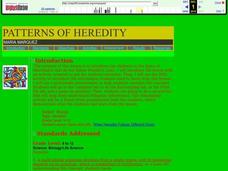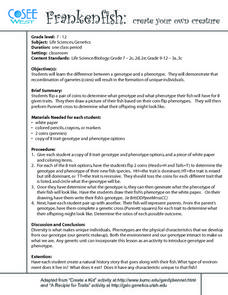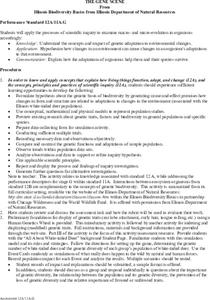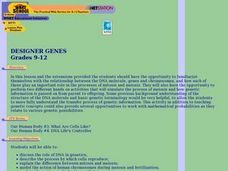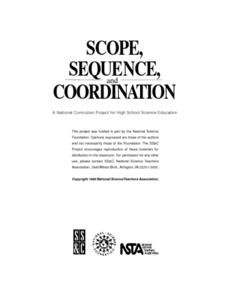Curated OER
Genetic Engineering
Students discuss the risks and benefits associated with biotechnology. In this biotechnology lesson, students discuss the role of genes in the body and brainstorm ethical issues relating to biotechnology. They read about an ethical issue...
Curated OER
TECH: Geneticist
A brief PowerPoint is used to introduce the class to the field of genetics by explaining the fields of work, the education required, and the job prospects. A trait inventory worksheet is completed by individuals, and then they gather...
ARKive
Biodiversity and Evolution – Darwin’s Finches
Teens experience natural selection firsthand (or first beak) in an activity that has them act as finches foraging for food. Using different household items to act as different beak styles, your little finches will collect as much...
Curated OER
Harvest of Fear
Learners research and debate the pros and cons of genetically altered foods. Students discuss whether they would be willing to eat genetically modified foods and whether these foods should be allowed to be created.
Curated OER
Clipbirds
Students attempt to pick up various objects with a wide variety of beaks, including scissors, spoons, etc.
Curated OER
Patterns of Heredity
Students describe the differences between incomplete dominance and codominant alleles, and between multiple alleles and polygenic inheritance. They describe how internal and external environments affect gene expression. They then...
Curated OER
Frankenfish
Students learn the difference between a genotype and a phenotype. They demonstrate that recombination of gametes (coins) will result in the formation of unique individuals.
Curated OER
Meiosiss Revisited
Seventh graders are engaged in a activity that covers the concept of meiosis with the intention of covered sexual reproduction. They cover the concept of genetic traits and how they are transmitted over generations with or without...
Curated OER
The Gene Scene
Young scholars investigate the concepts of micro and macro evolution. They also research the effects of mutations in the process of genetic adaptation to different environments. They develop a hypothesis of how the environment can...
Curated OER
The Watson-Crick Model of DNA Structure
Junior geneticists construct models of DNA to discover sequencing and pairing of nucleotides. They use the models to simulate protein synthesis and then translate the codes into physical traits. Finally, they use the traits to create a...
Serendip
The Molecular Biology of Mutations and Muscular Dystrophy
Different types of mutations cause unique types and degrees of muscular dystrophy. Scholars learn about the types of mutations and the impact on the body. They compare the location of the mutations and draw conclusions about how it is...
WK Kellogg Biological Station
Sounds of Selection
Do you want a creative and fun way to teach about natural selection? Hop to it by turning your middle school princes and princesses into frogs trying to catch as many bugs as possible in a Hungry Hungry Hippos style game. For high...
Curated OER
DNA, the Awesome Thread of Life
Students examine how traits are passed to offspring. In this genetic reproduction lesson students develop a model of dna and learn about its structure, replication and function.
Curated OER
On the Other Hand
Students identify traits that are either genetic or developmental in nature and determine why it might be difficult to learn if handedness is genetic or developmental. They explore theories on the causes of left-handedness by reading and...
Curated OER
Designer Babies
Students differentiate phenotypes and genotypes. In this genetics lesson, students complete the punnett square. They design their own baby by choosing the phenotype they want.
Curated OER
Toothpick Fish
Learners experiment with genes and environment for a population of "Toothpick Fish."
Curated OER
So Whose Cow is in the Field?
Learners, in rural classrooms, explain animal genetics. They study animals that are available in their locale.
Curated OER
EMS Lesson 2: Outrageous Offspring
Students investigate the principles of probability that can be used to predict hereditary traits.
Curated OER
Peanut Butter Broccoli
Fifth graders explore food production by viewing DNA presentations. In this genetic engineering lesson, 5th graders discuss the foods they typically eat at home and how many common foods are engineered in a way that can produce a bigger...
Curated OER
Making Babies
Sixth graders complete a human traits survey. For this genetics lesson students read articles and fill out a worksheet on genotype and phenotypes.
Curated OER
Natural Selection And Evolution
Seventh graders investigate the concept of natural selection and its relationship to the theory of evolution. They conduct research using a variety of resources and use the information to create a class presentation and open up the...
Curated OER
Designer Genes
Students view a video on DNA. They discuss mitosis, meiosis and fertilization. They use strips of paper to simulate fertilization and analyze the genotype and phenotype of the combined chromosomes.
Curated OER
Heredity Mix 'n Match
Students randomly select jelly beans that represent genes for several human traits such as tongue-rolling ability and eye color. Then, working in pairs (preferably of mixed gender), students randomly choose new pairs of jelly beans from...
Curated OER
Variations in Living Things
Biology beginners observe traits in a collection of plant parts to realize the tremendous amount of genetic variation within a species. They consider rules of nature and discuss what would happen if they changed. They also examine data...





